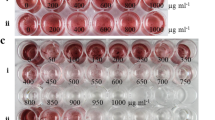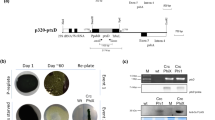Abstract
Genes conferring resistance to kanamycin are frequently used to obtain transgenic plants as spontaneous resistance to kanamycin is not known to exist in higher plants. Nevertheless, mutations conferring kanamycin resistance have been identified in Chlamydomonas reinhardtii, raising the question as to why kanamycin-resistant mutants have not been found in higher plants. While attempting plastid transformation of alfalfa, we obtained non-transgenic but kanamycin-resistant somatic embryos following 2 months of culture in the presence of 50 mg l−1 kanamycin. Sequencing of the plastid DNA region corresponding to the decoding site of the 16S rRNA in ten independent resistant events revealed an A to C transversion at position 1357 of the 16S plastid rDNA, the same site at which an A to G conversion confers kanamycin resistance to C. reinhardtii by reducing the ability of the antibiotic to bind to its target site. All plants derived from the resistant embryos through additional cycles of somatic embryogenesis in the absence of kanamycin retained the mutant phenotype, suggesting that the mutation was homoplastomic. Resistant plants produced 85% less biomass than controls; their leaves were chlorotic during early development and over time slowly turned green. The absence of kanamycin- resistant mutants in higher plants might be explained by the requirement for a regeneration system capable of resulting in homoplastomic individuals, or it may be the result of the detrimental effect of the mutation on the phenotype.


Similar content being viewed by others
References
Alangaden GJ, Kreiswirth BN, Aouad A, Khetarpal M, Igno FR, Moghazeh SL, Manavathu EK, Lerner SA (1998) Mechanism of resistance to amikacin and kanamycin in Mycobacterium tubercolosis. Antimicrob Agents Chemother 42:1295–1297
Austin S, Bingham ET, Matthews BF, Shahan MN, Will J, Burgess RR (1995) Production and field performance of transgenic alfalfa (Medicago sativa L.) expressing alpha-amylase and manganese-dependent lignin peroxidase. Euphytica 85:381–393
Bartlett SG, Harris EH, Grabowy CT, Gillham NW, Boynton JE (1979) Ribosomal subunits affected by antibiotic resistance mutations at seven chloroplast loci in Chlamydomonas reinhardtii. Mol Gen Genet 176:199–208
Bateman JM, Purton S (2000) Tools for chloroplast transformation in Chlamydomonas: expression vectors and a new dominant selectable marker. Mol Gen Genet 263:404–410
Bevan MW, Flavell RB, Chilton MD (1983) A chimaeric antibiotic resistance gene as a selectable marker for plant cell transformation. Nature 304:184–187
Bingham ET (1991) Registration of alfalfa hybrid Regen-SY germplasm for tissue culture and transformation research. Crop Sci 31:1098
Brosius J, Palmer LM, Kennedy PJ, Noller F (1978) Complete nucleotide sequence of a 16S ribosomal RNA gene from Escherichia coli. Proc Natl Acad Sci USA 75:4801–4805
Brown DCW, Atanassov A (1985) Role of genetic background in somatic embryogenesis in Medicago. Plant Cell Tissue Organ Cult 4:111-122
Davies J, Gorini L, Davis BD (1965) Misreading of RNA codewords induced by aminoglycoside antibiotics. Mol Pharmacol 1:93–106
Dix PJ, Kavanagh TA (1995) Transforming the plastome-genetic-markers and DNA delivery systems. Euphytica 85:29–34
Doyle JJ, Doyle JL (1990) Isolation of plant DNA from fresh tissue. Focus 12:13–15
Dron M, Rahire M, Rochaix JD (1982) Sequence of the chloroplast 16S rRNA gene and its surrounding regions of Chlamydomonas reinhardtii. Nucleic Acids Res 10:7609–7620
Edelmann P, Gallant J (1977) Mistranslation in E. coli. Cell 10:131–137
Gregory ST, Dahlberg AE (1995) Nonsense suppressor and antisuppressor mutations at the 1409–1491 base-pair in the decoding region of Escherichia coli 16S ribosomal RNA. Nucleic Acids Res 23:4234–4238
Gutell RR (1994) Collection of small subunit (16S- and 16S-like) ribosomal RNA structures. Nucleic Acids Res 22:3502–3507
Harris EH, Burkhart BD, Gillham NW, Boynton JE (1989) Antibiotic resistance mutations in the chloroplast 16S and 23S rRNA genes of Chlamydomonas reinhardtii: correlation of genetic and physical maps of the chloroplast genome. Genetics 123:281–292
Herrera-Estrella L, De Block M, Messen E, Hernalstens JP, Van Montagu M, Schell J (1983) Chimeric genes as dominant selectable markers in plant cells. EMBO J 2:987–995
Huang FC, Klaus SMJ. Herz S, Zou Z, Koop HU, Golds TJ (2002) Efficient plastid transformation in tobacco using the aphA-6 gene and kanamycin selection. Mol Genet Genomics 268:19–27
Jerinic O, Joseph S (2000) Conformational changes in the ribosome induced by translational miscoding agents. J Mol Biol 304:707–713
Moazed D, Noller HF (1987) Interaction of antibiotics with functional sites in 16S ribosomal RNA. Nature 327:389–394
Moazed D, Noller HF (1990) Binding of tRNA to the ribosomal A and P sites protects two distinct sets of nucleotides in 16S rRNA. J Mol Biol 211:135–145
Murashige T, Skoog F (1962) A revised medium for rapid growth and bioassays with tobacco tissue cultures. Physiol Plant 15:473–597
Recth MI, Douthwaite S, Puglisi JD (1999a) Basis for prokaryotic specificity of action of aminoglycoside antibiotics. EMBO J 18:3133–3138
Recth MI, Douthwaite S, Dahlquist KD, Puglisi JD (1999b) Effect of mutations in the A site of 16S rRNA on aminoglycoside antibiotic-ribosome interaction. J Mol Biol 286:33–43
Sambrook J, Fritsch EF, Maniatis T (1989) Molecular cloning: a laboratory manual, 2nd edn. Cold Spring Harbor Laboratory Press, Cold Spring Harbor
See D, Kanazin V, Talbert H, Blake T (2000) Gel-based detection of single nucleotide polymorphisms. Biotechniques 28:710–716
Skeggs PA, Thompson J, Cundliffe E (1985) Methylation of 16S ribosomal RNA and resistance to aminoglycoside antibiotics in clones of Streptomyces lividans carrying DNA from Streptomyces tenjimariensis. Mol Gen Genet 200:415–421
Smith SE, Bingham ET, Fulton RW (1986) Transmission of chlorophyll deficiencies in Medicago sativa—evidence for biparental inheritance of plastids. J Hered 77:35–38
Stewart CN Jr, Adang MJ, All JN, Boerma HR, Cardineau G, Tucker D, Parrott WA (1996) Genetic transformation, recovery, and characterization of fertile soybean [Glycine max (L.) Merrill] transgenic for a synthetic Bacillus thuringiensis CRY IA(c) gene. Plant Physiol 112:121–129
Wilhelm JM, Pettitt SE, Jessop JJ (1978) Aminoglycoside antibiotics and eukaryotic protein synthesis: structure-function relationships in the stimulation of misreading with a wheat embryo system. Biochemistry 17:1143–1149
Woodcock J, Moazed D, Cannon M, Davies J, Noller HF (1991) Interaction of antibiotics with A- and P-site-specific bases in 16S ribosomal RNA. EMBO J 10:3099–3103
Yeh KC, To KY, Sun SW, Wu MC, Lin TY, Chen CC (1994) Point mutations in the chloroplast 16S ribosomal RNA gene confer streptomycin resistance in Nicotiana plumbaginifolia. Curr Genet 26:132–135
Acknowledgements
Support for this research was provided by State and Hatch money allocated to the Georgia Agricultural Experiment Station. D.R. acknowledges NATO Advanced Fellowship Programme 1999, grant no. 215.32 that supported his stay at The University of Georgia. The assistance of Gabriella Petesse and Greg Martin is gratefully acknowledged.
Author information
Authors and Affiliations
Corresponding author
Additional information
Communicated by C.F. Quiros
Rights and permissions
About this article
Cite this article
Rosellini, D., LaFayette, P.R., Barone, P. et al. Kanamycin-resistant alfalfa has a point mutation in the 16S plastid rRNA. Plant Cell Rep 22, 774–779 (2004). https://doi.org/10.1007/s00299-004-0757-3
Received:
Revised:
Accepted:
Published:
Issue Date:
DOI: https://doi.org/10.1007/s00299-004-0757-3




